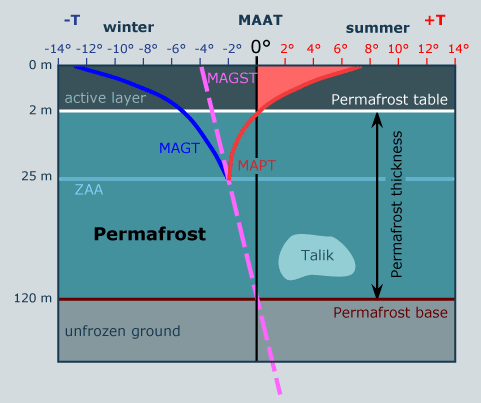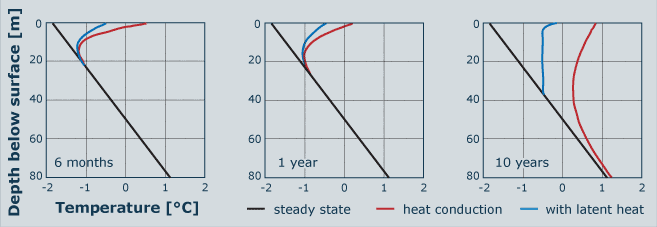 |
|
|
|
|
|
|
Definition |
|

|
Figure 1 illustrates common permafrost terminology. Even though Mean Annual Ground Temperature (MAGT) in permafrost lies below 0°C, the uppermost surface layer is subject to seasonal thaw during the summer and, thus, called active layer. Its thickness can vary from summer to summer; typical values in the Alps are a few meters. At the base of the active layer, the permafrost table forms the upper boundary of the permafrost body. The maximum annual temperature here is never above 0°C. The lower boundary of permafrost is called the permafrost base and is defined by the 0°C-isotherme in the ground. In the Alps, permafrost bodies have typical depths of a few 10s of metres in debris up to more than 1 km in the bedrock of the highest summits. While the position of the permafrost base is a function of the Mean Annual Ground-Surface Temperature (MAGST) and the geothermal heat flux over a very long time, the permafrost table and the depth of the active layer react to seasonal changes of the surface temperature. The temperature at the Zero Annual Amplitude (ZAA) is called Mean Annual Permafrost Temperature (MAPT) |
|
1 - Schematic cross-section through permafrost illustrating important terms. The temperature profiles are plotted with temperature data from the borehole Murtèl-Corvatsch, Switzerland |
| The major surface temperature variation caused by the cycle of solar radiation has a period of one year. This variation introduces a temperature wave which propagates downward into the ground. With increasing depth, the amplitude diminishes and a phase lag can be observed. The Zero Annual Amplitude (ZAA) is the depth at which annual temperature fluctuations are dampened to less than 0.1°C. In the Alps, this depth can be found at around 20 m below the surface. The MAGT is defined as the temperature at the depth of the permafrost table. |
|
In soils with high water content, the so-called zero curtain can be observed twice a year: When temperatures decrease in autumn, the active layer freezes. However, the ground temperature within this layer does not fall linearly, but stops at 0°C, due to latent heat release. Similarly, in spring/summer, when the temperatures within the active layer are increasing, energy is needed for the phase change from ice to water. As a consequence, the temperature will remain at 0°C for a while. Permafrost is active if the active layer freezes completely during winter. If the winter frost does not reach the permafrost table, the permafrost body is called inactive. In this case an unfrozen talik lies between the seasonally and perennially frozen layers. Relict permafrost originating from earlier cold-phases, can have unfrozen zones below the surface down to 100 m or more. Permafrost exists within about 20% of the earth land surface. The phenomenon has been well known to the native arctic inhabitants for many centuries. The beginning of scientific research started with temperature measurements in mines and boreholes at Yakutsk (Siberia) in 1930 by A. von Middendorfs. In the year 1943, the name ‘permafrost’ (permanent frost) was introduced by S. Muller. Every five years since 1963 an International Conference on Permafrost takes place at a different location (1973 Yakutsk, 1978 Edmonton, 1983 Fairbanks, 1988 Trondheim, 1993 Beijing, 1998 Yellowknife, 2003 Zurich). |

|
| 2 - Boreholes have to be drilled to derive temperature measurements in the permafrost (148K) |

|
|
3 - Modeled warming of ground temperatures with and without
phase change for a ground with 60% moisture content. A step change in
air temperature from -2°C to +1°C was taken. The black
line indicate the initial steady state profile. The red
line indicates the calculation without phase change and the blue
line with phase change. |
29 August 2011 |
||
| |
||